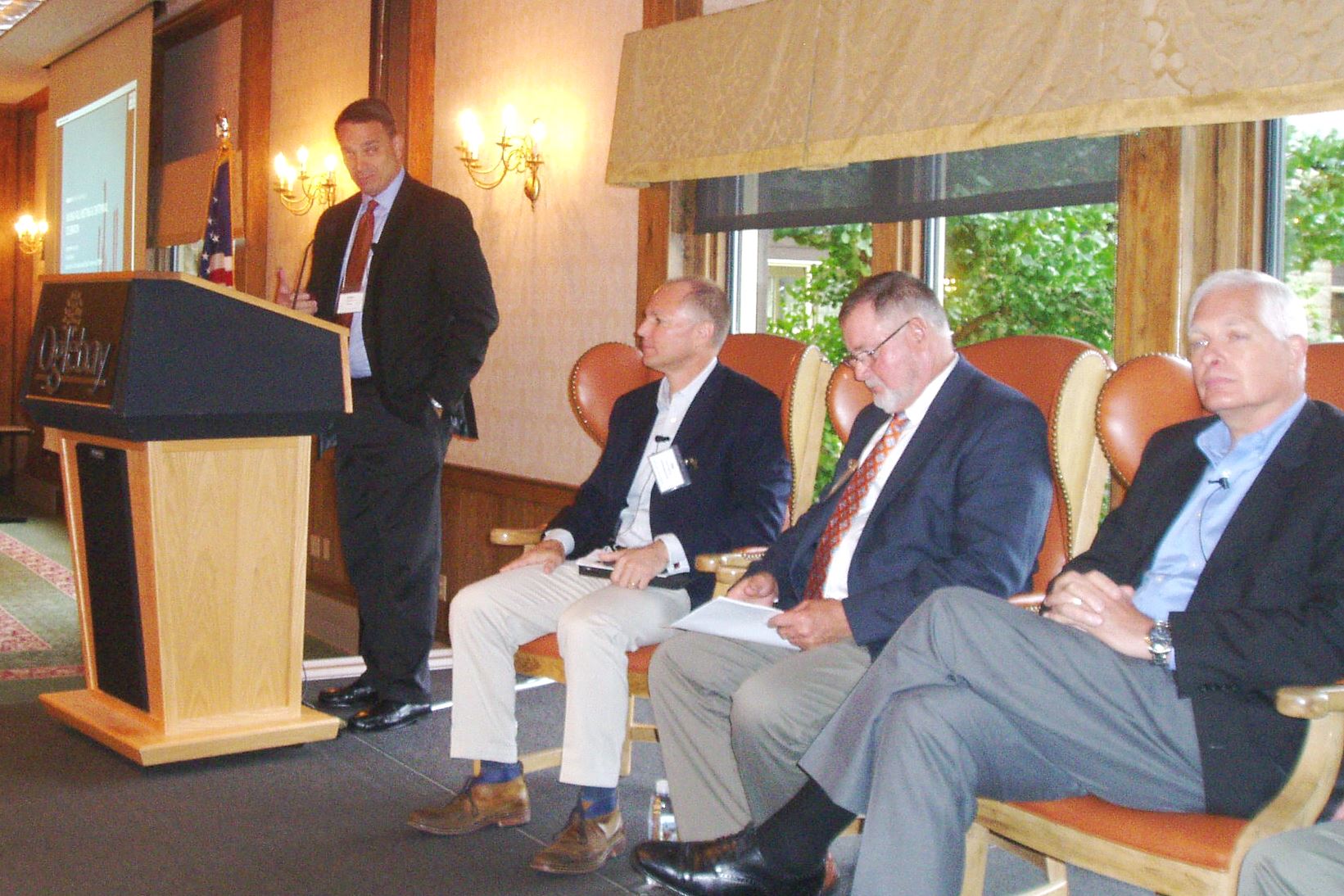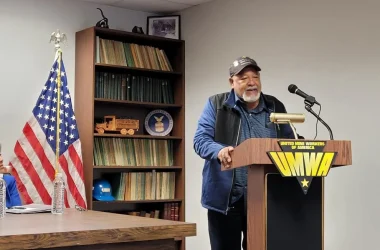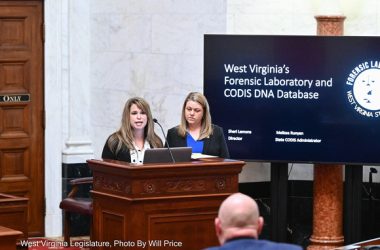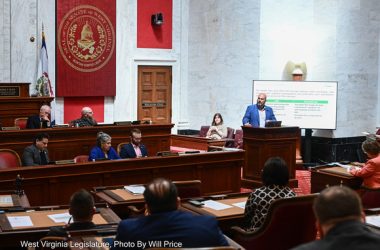
By GEORGE HOHMANN
For the West Virginia Press Association
CHARLESTON, W.Va. — The sales price for a unit of natural gas is a down dramatically, but industry leaders say interest and investment in West Virginia’s natural gas industry continues to climb.
But top executives of several companies developing the Marcellus and Utica shales in northern West Virginia, Ohio and Pennsylvania recently outlined the ongoing investments in West Virginia.Al Schopp, chief administrative officer, regional vice president and treasurer of Antero Resources Corp., said there’s also been a lot of talk in West Virginia over the past five years about a lack of local trained labor but “we’ve trained the local resource.
“We’re the most active driller in West Virginia because we feel committed to keep those resources so we don’t go back to where we were five years ago in this area,” he said. “We need those local resources, to be productive.”When subcontractors are added to the number of people working for Antero, “we have about 2,000 full-time equivalents still working for us here in West Virginia,” Schopp said. “It’s a big thanks to them for any of our success.”
Speaking at the recent West Virginia Oil and Natural Gas Association’s annual meeting at Oglebay Resort, Schopp said Antero operated 15 drilling rigs in West Virginia last year and is operating 6 in the state this year. “We have 390,000 acres in West Virginia. We have approximately 3,000 (potential drilling) locations.”
“Our development plan is for the next 30-plus years,” he said. “Our long-term headquarters for both Ohio and West Virginia is in Bridgeport (W.Va.). We’re committed to West Virginia for the long term. We were not the first guy in but we hope to be the last guy out.”Antero’s primary area of operation in West Virginia runs across U.S. Route 50 from Bridgeport to Parkersburg and north into Tyler and Wetzel counties.
Antero has spent almost $5 billion in West Virginia since it drilled its first well in the state in 2009, Schopp said. “In 2014 we spent over $2 billion in West Virginia. In 2015 we’ll still have $1 billion we’re going to spend in West Virginia.”
Antero has spent millions on reducing the environmental impact of its operations and plans to spend millions more, Schopp said.
Soon after arriving in West Virginia in 2008 it became obvious to the company that “any kind of truck trips on these narrow roads were not going to endear us much to the local community,” he said.
“We embarked on a $500 million project to lay water lines — to deliver water — to 100 percent of our fracks (wells that use horizontal drilling and hydraulic fracturing). This project took over two years to build. In 2014 we eliminated 400,000 water truck trips by delivering water through this system from the West Fork or Ohio rivers all the way to the well pad. In 2015 we believe that will be another 325,000 water truck trips.
“Phase Two is, we just committed $300 million to what we call the Antero Clearwater Facility. It will be a 60,000-barrel-a-day treatment plant that will take produced (used) water from both Utica and Marcellus plays and out of that will come 50,000 barrels of stream-quality water that could be put right into a stream with the proper permitting” plus salt and sludge. Salt and sludge are West Virginia-qualified landfill material or they could be sold, he said.
“The 50,000 barrels of water — instead of releasing it to a stream… we will push that water at the plant right back into the system and it will then go through our freshwater distribution system. We will put no produced water of any type in any of the pipelines that are running across West Virginia.
“This will be clean water going directly back in to fully recycle all of the water instead of just taking polished water and pumping it back down a hole. We’ll only be pumping fresh water. We’re very excited about this project. It’s scheduled to come up in the fall of 2017; it’s a two-year project.”
Schopp also said the company has made a commitment to have an independent safety consultant at every major Antero construction, drilling, fracking and drill-out operation, 24 hours a day, seven days a week, 365 days a year. “That’s a commitment of more than $20 million a year,” he said.
Gregory Floerke, executive vice president and chief commercial officer of MarkWest Energy Partners, said MarkWest has constructed 32 major facilities during the past few years, including the Sherwood Plant in Doddridge County and the Majorsville Plant in Marshall County.
“We are continuing to develop Marcellus and Utica opportunities,” Floerke said. “We want to make this basin a major natural gas liquids hub for the United States. We think it can be. It’s not directly on the water but with a combination of pipelines and East Coast and Gulf Coast terminals and even unit trains for natural gas liquids, we feel the opportunity is here.
“But it isn’t just about exports,” he said. “It’s also about in-region demand. We’re excited about the potential steam cracker projects that will create in-region demand for ethane. We’re also excited about opportunities with Marathon and other refiners.”
Steve Mueller, chairman and chief executive officer of Southwestern Energy Co., said that after the Great Recession, natural gas prices in Japan and Europe went up while prices in the United States went down.
Everywhere in the U.S. but the Northeast has a natural gas price advantage over the rest of the world, Mueller said. “I contend what’s happening and what you’ll see over the next 10 years — and it’s something West Virginia has the potential to capture — is that business is coming here.
“You see it every day,” he said. “In the last three months a French company, a German company and a Korean company have all announced that rather than expanding plants in their countries, they’re coming to the United States and building new plants or expanding plants in the United States.”
The reason for that is the price advantage in the U.S., he said.
Southwestern Energy has about 2,800 locations in the Marcellus Shale and 1,600 in the Utica Shale where it plans to drill, Mueller said.
Stan Chapman, Columbia Pipeline Group’s executive vice president and chief commercial officer, said over the past two to three years Columbia has developed a backlog of about $10 billion worth of projects predominantly funded by producers like Antero and Southwestern Energy to get their gas out of this region.
“The impact — and I don’t think Columbia is necessarily unique from a pipeline perspective — is that we’re actually going to triple the size of our company, from a rate-base perspective, between now and 2018,” he said. “Triple the size, going from a four-billion-dollar net investment company to almost a thirteen-and-a-half billion dollar net investment company.”





